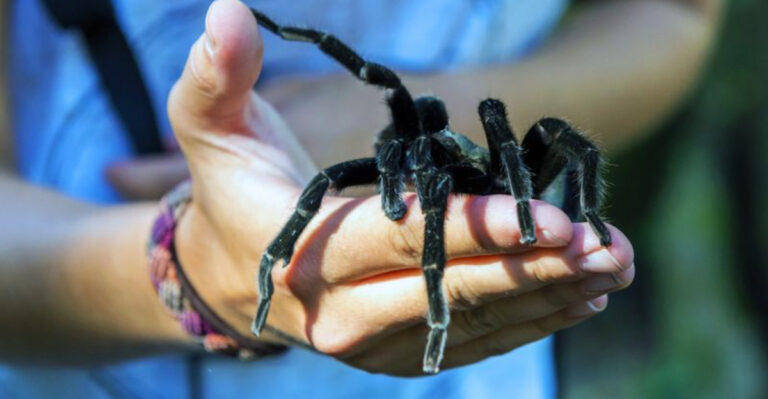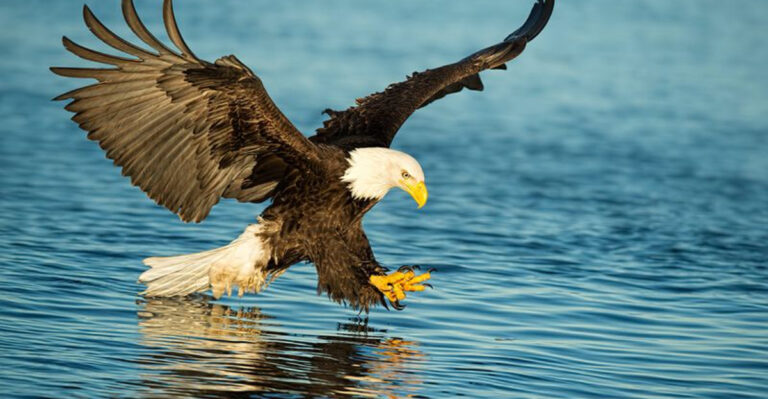14 Snake Species That Are Surprisingly Skilled At Climbing Trees
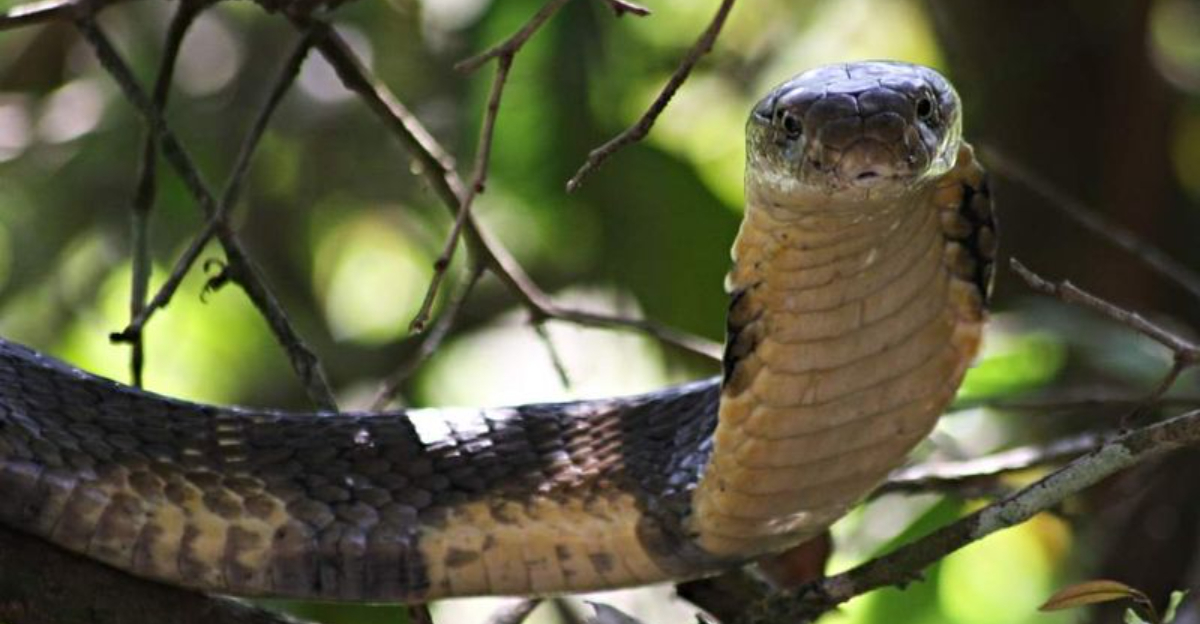
When we think of animals climbing trees, monkeys and squirrels usually come to mind first. But many snake species are remarkably adept at scaling tree trunks and navigating branches.
These slithery creatures use their muscular bodies and specialized scales to grip bark and move vertically with surprising ease. Let’s explore 14 snake species that demonstrate impressive tree-climbing abilities.
1. Green Tree Python
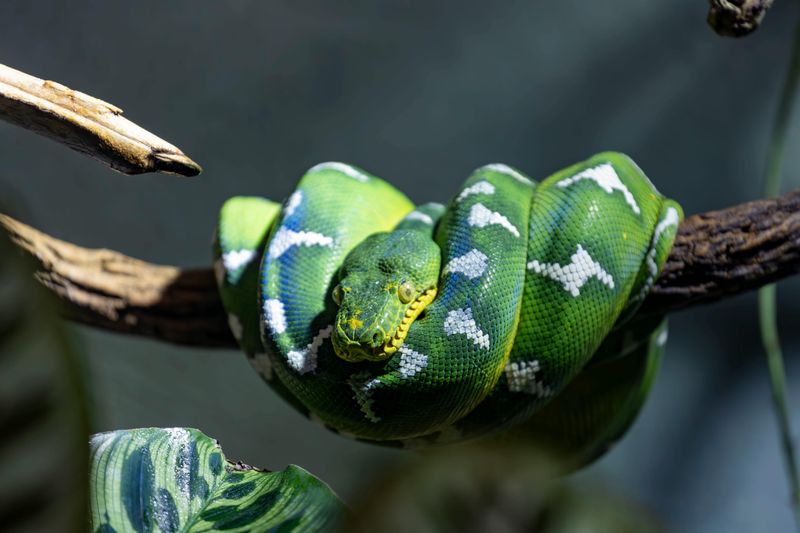
Wrapped around branches like living jewelry, Green Tree Pythons evolved specifically for life above ground. Their bright emerald coloration provides perfect camouflage among tropical foliage.
Using their prehensile tails as anchors, these pythons rarely descend to the forest floor. Instead, they ambush birds and small mammals from their lofty perches, striking with lightning precision.
2. Emerald Tree Boa

Often mistaken for Green Tree Pythons, Emerald Tree Boas showcase convergent evolution at its finest. Both species developed similar appearances despite evolving separately on different continents.
Their specialized heat-sensing pits help detect warm-blooded prey moving through the canopy. With impressive jaw flexibility, they can swallow creatures larger than their own head while maintaining their grip on branches.
3. Rat Snake
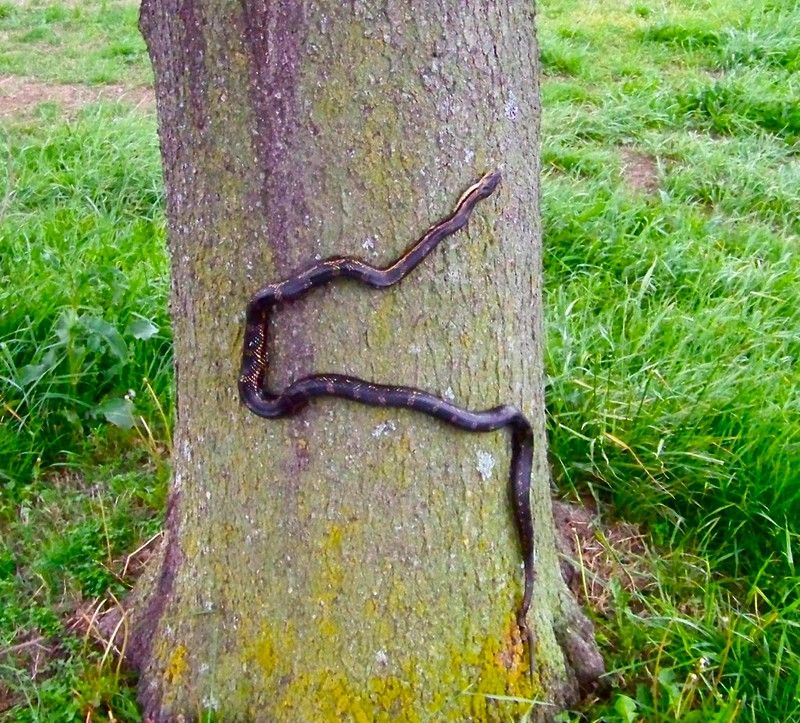
Masters of versatility, Rat Snakes confidently climb vertical surfaces that would challenge most reptiles. Their keeled scales act like tiny hooks, gripping bark as they ascend in search of bird nests.
Unlike strictly arboreal species, these adaptable hunters excel both on the ground and in trees. Farmers often appreciate their presence as natural rodent control, making them beneficial tree-climbers worth protecting.
4. Carpet Python

Australia’s Carpet Pythons possess remarkable strength that makes tree-climbing look effortless. Their muscular bodies can support their weight while stretched between branches, creating living bridges in the canopy.
Young specimens spend more time in trees than adults, who grow heavier with age. Their intricate patterns serve dual purposes—camouflage among dappled sunlight and attracting mates during breeding season.
5. Vine Snake
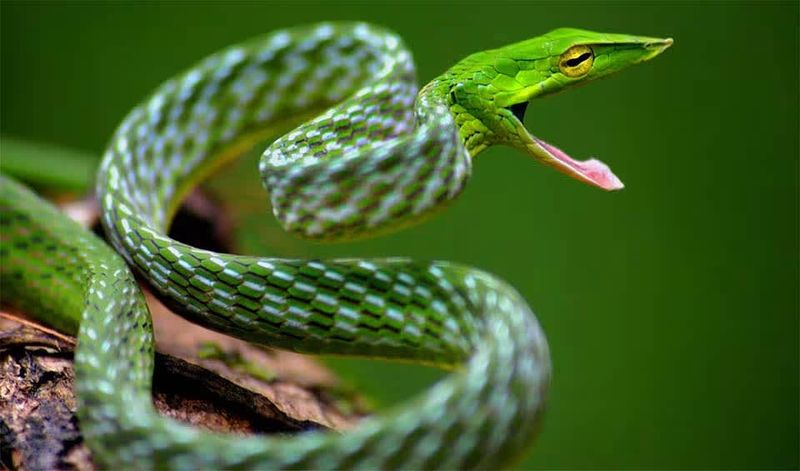
Perfectly mimicking the plants they’re named for, Vine Snakes represent nature’s ultimate disguise artists. Their pencil-thin bodies and pointed heads create an almost perfect plant imitation when motionless.
Horizontal pupils give them enhanced depth perception crucial for judging distances between branches. When hunting, they transform from stationary “vines” to lightning-fast predators, striking with surgical precision at lizards and frogs.
6. King Cobra
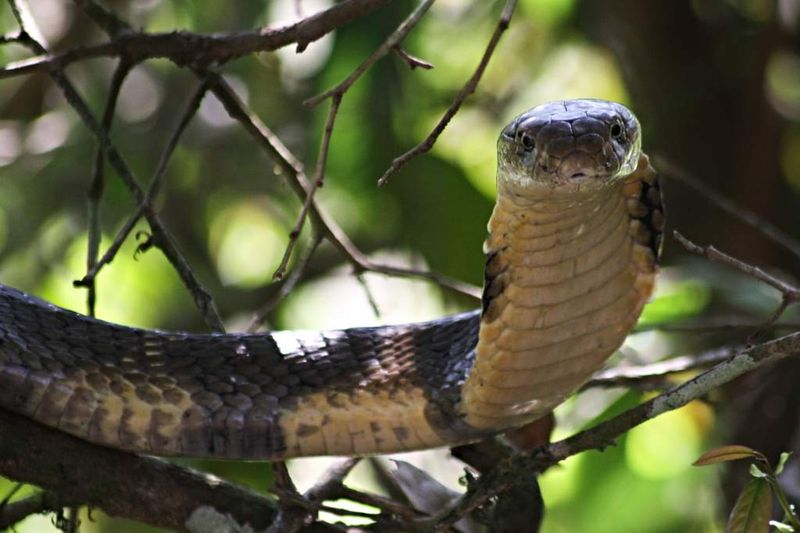
Surprisingly nimble for their impressive size, King Cobras can ascend trees with unexpected grace. Unlike smaller arboreal specialists, these massive reptiles climb primarily to raid bird nests or escape floods.
Their intelligence sets them apart—they assess branch strength before committing their weight. When threatened while climbing, they can maintain balance while simultaneously displaying their iconic hood, creating an intimidating silhouette against the sky.
7. Green Mamba

Sleek and lightning-fast, Green Mambas navigate tree canopies with ballet-like precision. Their vibrant coloration isn’t just beautiful—it’s perfect camouflage among sun-dappled leaves where they hunt.
Unlike their ground-dwelling black mamba cousins, green mambas rarely descend to earth. Their venom contains unique neurotoxins specially evolved to quickly immobilize birds that might otherwise escape through flight.
8. Cuban Tree Boa

Nocturnal acrobats of the Caribbean, Cuban Tree Boas possess incredible grip strength that borders on supernatural. Their bodies can form loops that maintain secure holds even when the snake appears precariously balanced.
Unique among climbing snakes, they employ a bizarre “lasso” technique to ascend smooth surfaces. This adaptation allows them to climb palm trees lacking branches or texture that would defeat most other snake species.
9. Black Rat Snake

Farmland favorites across North America, Black Rat Snakes combine climbing prowess with practical benefits. Their glossy scales might appear smooth, but contain microscopic ridges perfect for gripping rough bark.
Young specimens display distinct patterns that fade to solid black with age. Despite their intimidating size—often exceeding six feet—these gentle giants prefer fleeing to confrontation when discovered in their arboreal hideouts.
10. Timber Rattlesnake

Breaking stereotypes about rattlesnakes staying grounded, Timber Rattlesnakes occasionally embrace arboreal adventures. Young specimens particularly enjoy basking on sun-warmed branches where predators can’t easily reach them.
Their climbing behavior varies by region and season. Unlike specialized tree dwellers, they climb with cautious determination rather than fluid grace, carefully testing each surface before transferring their weight forward.
11. Burmese Python

Defying expectations for such massive snakes, juvenile Burmese Pythons climb with surprising agility. Their tree-climbing abilities diminish as they grow heavier, but even adults can ascend sturdy trunks when motivated.
In their native range, young pythons use trees as safety zones from predators and flooding. Their incredible muscle control allows them to lock into position, remaining motionless for hours while waiting for prey to pass beneath.
12. Brown Tree Snake
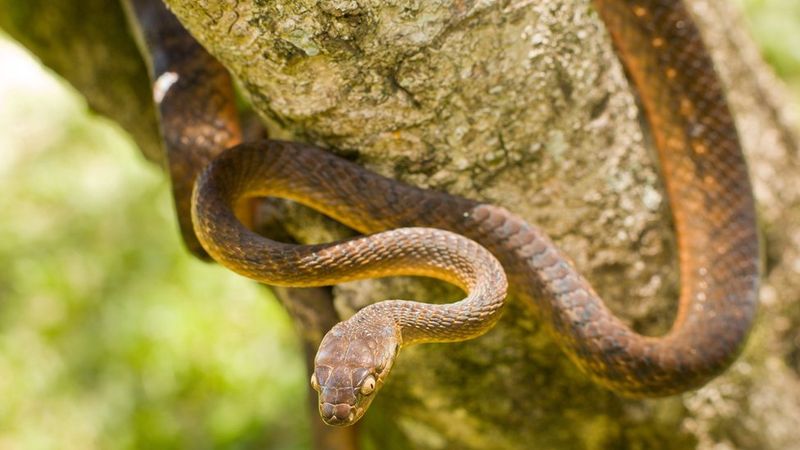
Infamous for decimating Guam’s bird populations, Brown Tree Snakes possess extraordinary climbing abilities that helped them access previously protected nests. Their slightly compressed bodies and rough scales create incredible friction against almost any surface.
Even smooth metal poles pose little challenge to these determined climbers. Their nocturnal hunting strategy involves moving slowly along branches, using their excellent night vision to detect sleeping birds before striking.
13. Amazon Tree Boa
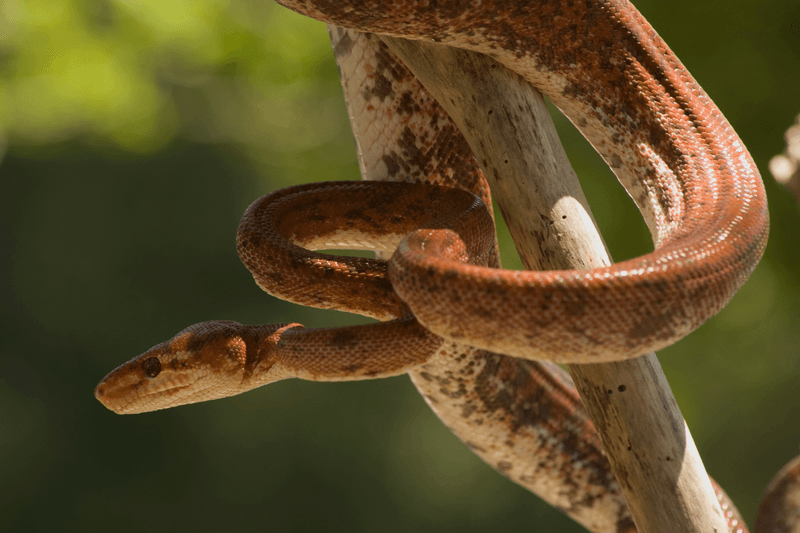
Sporting wildly variable color patterns from brick red to silver gray, Amazon Tree Boas are canopy specialists with attitude. Their slender bodies can extend remarkable distances between branches without losing balance.
Unlike many arboreal snakes, they don’t rely solely on camouflage. Instead, they actively defend their perches with dramatic threat displays, coiling tightly and striking repeatedly when disturbed, though their bite isn’t dangerous to humans.
14. Mangrove Snake
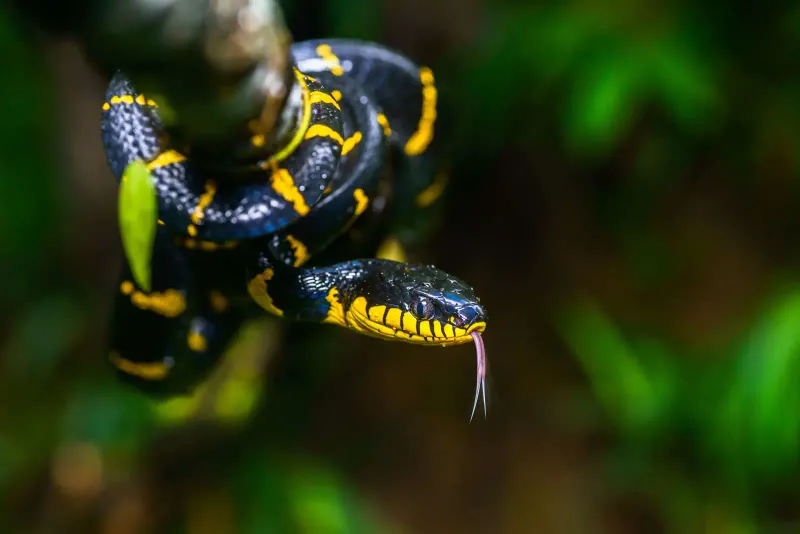
Elegant midnight hunters, Mangrove Snakes navigate the complex root systems of coastal forests with remarkable precision. Their glossy black bodies adorned with yellow bands become nearly invisible during moonless nights.
Specialized for hunting in three dimensions, they can strike accurately in complete darkness. Though mildly venomous, they rely more on constriction after capturing prey, wrapping around branches for leverage while subduing struggling victims.





